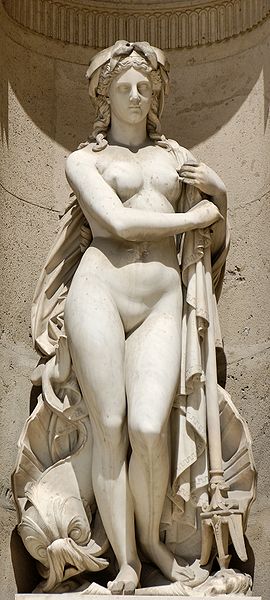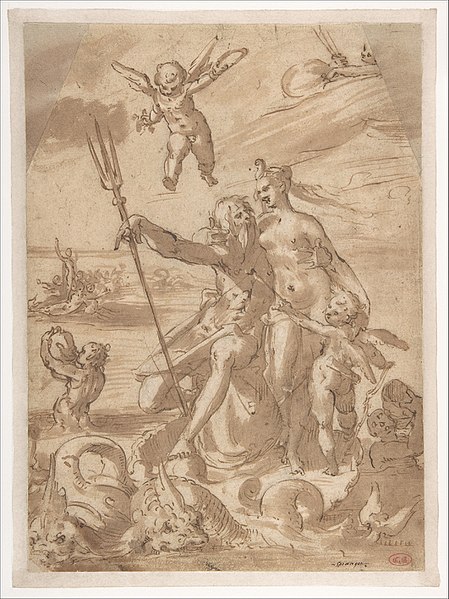We’ve already seen the story of the Nereids, Greek mythology’s enchanting sea nymphs. Amphitrite, the sea’s queen and goddess, was among them. Amphitrite, one of the goddesses who piqued my interest, especially when I was younger, became the symbolic representation of the sea, giving birth to sea animals as well as monsters, and her great waves were used to punish sailors who attempted to harm the sea. Let’s find out more about this enchanting goddess and consort of Poseidon.
Amphitrite Key Facts
| Parents | Nereus and Doris |
| Partners | Poseidon |
| Siblings | Nereids (sea nymphs) |
| Offspring | Triton and others |
| Other names | – |
| Roman name | Salacia |
| The Goddess of | The Sea |
| Symbols | Dolphin, sea, trident |
Name and Etymology
Amphitrite’s name resonates with the vastness and depth of the oceans she rules. Derived from the Greek words “amphi” meaning “around” and “tritos” meaning “third,” her name can be translated as “the third one who encircles.” This could be a reference to the three main seas of the ancient Greek world: the Aegean, Ionian, and Adriatic.
In Roman mythology, she is identified as Salacia, the goddess of saltwater. Salacia’s name, derived from “sal,” meaning “salt” in Latin, emphasizes her dominion over the salty depths of the sea.
While Amphitrite is her most recognized name, she is also sometimes referred to by epithets that highlight her attributes or her relationship with Poseidon. These epithets, though not as commonly used, further accentuate her significance in the pantheon of Greek deities.

Amphitrite Origins
Amphitrite hails from a lineage deeply connected to the sea. She is the daughter of Nereus and Doris, making her one of the fifty Nereids or sea nymphs.
Sea nymphs were renowned for their beauty and connected to various aspects of the ocean, from calm waves to raging storms. Amphitrite’s birth or childhood doesn’t have much detailed information. However, considering her lineage, she likely spent her early days with her Nereid sisters, dancing on the shores and exploring the vast underwater realms.
In terms of her role in Greek mythology, Amphitrite isn’t just a sea nymph; she embodies the calm and serene aspects of the sea. While Poseidon represents the tumultuous and sometimes violent nature of the oceans, Amphitrite brings balance with her calm demeanor and grace.

Amphitrite’s Family Life
Amphitrite’s union with Poseidon is one of the most celebrated tales in Greek mythology. Poseidon, the mighty god of the sea, was captivated by Amphitrite’s beauty and grace. However, winning her heart wasn’t straightforward. When Poseidon first expressed his interest, Amphitrite, perhaps wary of his formidable reputation or overwhelmed by his advances, sought refuge in the Atlas, The Titan Who Held Up the Sky, Mountains. But Poseidon’s determination was unwavering. He dispatched his messenger, the dolphin god Delphin, to locate and persuade her. Delphin, known for his eloquence and charm, successfully wooed Amphitrite on Poseidon’s behalf, highlighting the deep love and respect Poseidon held for her.
Their subsequent marriage was a grand celestial event, attended by gods, goddesses, and sea creatures. The union of the sea god and the sea nymph was symbolic, representing the perfect harmony of the ocean’s mighty power and serene beauty.
Children of Amphitrite and Poseidon
While Triton is the most renowned offspring of Amphitrite and Poseidon, their union bore other children as well. Triton, often depicted as a merman with a conch shell, played a significant role as Poseidon’s herald. His conch shell had the power to calm or stir the seas, reflecting the combined influences of both his parents.
Triton, Rhode, and Benthesikyme were blessings to Amphitrite and Poseidon. Rhode, linked to the island of Rhodes, became its sea nymph or goddess. Meanwhile, Benthesikyme lived in the ocean’s depths as the sea nymph, representing the sea’s calm and tranquil aspects, just like her mother.
Together, this family ruled the vast oceans, each member playing a unique role in the myths and tales of ancient Greece. Their stories intertwine, reflecting the complexities, challenges, and joys of divine family life.
Depiction And Characteristics
Amphitrite’s beauty is legendary. Often, she’s portrayed with long flowing hair, a crown of seaweed or coral, and a robe that mirrors the colors of the ocean. In some depictions, she rides a chariot pulled by sea creatures, showcasing her authority over the marine realm. Symbols associated with her include the dolphin, a testament to the role dolphins played in her union with Poseidon.
Personality and Powers
Poseidon, her husband, often displays the unpredictable nature of the sea, while Amphitrite represents the ocean’s serene and tranquil aspects. She exudes grace, kindness, and a profound understanding of the vast realm she governs.
As a sea goddess, Amphitrite possesses control over the oceans and all marine life. She can command the seas to be calm or turbulent. While Poseidon’s wrath can cause storms and earthquakes, Amphitrite’s influence brings balance, ensuring harmony in the marine realm.
Symbols and Roles of Amphitrite
Amphitrite, as the queen of the seas, is intrinsically tied to various symbols and roles that reflect her dominion over the marine realm. Her significance goes beyond just being Poseidon’s consort; she embodies the very essence of the ocean’s calm and nurturing facets.
Amphitrite’s Emblematic Symbols
The dolphin holds a special place in Amphitrite’s lore. This graceful marine creature not only played a pivotal role in uniting her with Poseidon but also symbolizes the playful and nurturing aspects of the sea she embodies. Dolphins, often seen leaping joyfully in the ocean, represent the serene and harmonious side of the marine world, a direct reflection of Amphitrite’s influence.
Seaweed and coral, frequently used to adorn her in artistic depictions, signify her deep connection to the marine world. These elements, integral to the ocean’s ecosystem, highlight Amphitrite’s nurturing role, ensuring balance and harmony in the depths.
Roles in the Marine Realm
Amphitrite’s primary role is as the queen of the sea, overseeing the vast oceans and ensuring harmony within its depths. While Poseidon’s responsibilities often extend to earthquakes and horses, Amphitrite’s focus remains primarily on the marine realm. She ensures safe passage for sailors, nurtures marine life, and balances the unpredictable nature of the oceans.
In many tales, she’s seen calming the tempestuous seas, ensuring that sailors return safely to their homes. Her influence is a counterbalance to Poseidon’s might, bringing tranquility where there’s turmoil. Moreover, as a mother, she also plays a protective role, especially towards her children, ensuring they navigate the challenges of the divine world.
Representations Of Amphitrite In Art
Amphitrite, as the goddess-queen of the sea and wife of Poseidon, has been a popular subject in ancient art. Her depictions often draw parallels with Aphrodite, but certain distinct attributes set her apart. For instance, Amphitrite’s hair is sometimes enclosed within a net, and her brow might be adorned with crab-claw “horns”. These symbols emphasize her dominion over the sea and its creatures.
In Greek vase paintings, Amphitrite is often portrayed as a young woman. In some she is making a pinching gesture, or holding a fish. Mosaics frequently showcases the goddess riding beside Poseidon in a chariot drawn by fish-tailed horses or hippocampi. Such depictions not only highlight her status as Poseidon’s consort but also her role as the personification of the sea.
Several ancient artworks have immortalized Amphitrite. For instance, the temple of Poseidon on the Corinthian isthmus housed a statue of her. Additionally, her figure graced the relief ornaments of the temple of Apollo at Amyclae.
The Villa Albani notably displays a colossal statue of Amphitrite. Moreover, coins from Syracuse often feature her, highlighting her importance in ancient maritime cultures. A particularly exquisite depiction of Amphitrite graces the arch of Augustus at Rimini.

Mentions in Ancient Texts
Her presence and significance are evident in the works of various poets, historians, and mythographers.
Homer’s Odyssey
In this epic, Amphitrite is mentioned several times. Seals are described as the “brood of lovely Halosydne [Amphitrite]” (Odyssey 4.404). Odysseus, The Cunning Hero Of The Trojan War expresses his fear that a sea monster, a creature from the breeding grounds of Amphitrite, might be sent against him (Odyssey 5.421 ff). The sea’s mighty billows, crashing against rocks known as the “Planktai (Planctae, Wanderers),” are associated with “Amphitrite, the goddess of blue-glancing seas” (Odyssey 12.60 ff).
Hesiod’s Theogony
Hesiod speaks of the Nereides, including Amphitrite, who have the power to calm the waters and hush the winds (Theogony 252 ff).
Homeric Hymn to Delian Apollo
In this hymn, the poet portrays Amphitrite as one of the chief goddesses, witnessing the birth of Apollo on the island of Delos (Homeric Hymn 3 to Delian Apollo 89 ff).
Pindar’s Olympian Ode
Pindar refers to Poseidon as the “husband of Amphitrite, goddess of the gold spindle” (Olympian Ode 6.105 ff).
Timotheus’ Fragments
The poet describes a naval battle where the “barbarian naval host” is driven back on the “fish-wreathed bosom of Amphitrite with its gleaming folds” (Fragment 79).
Pausanias’ Description of Greece
In his travel writings, Amphitrite is associated with various descriptions and offerings. For instance, in the temple of Poseidon at Korinthos, there are depictions of Amphitrite alongside Poseidon and the boy Palaimon (Pausanias, Description of Greece 2.1.7). Another temple at Amyklai in Lakonia features reliefs of Amphitrite with Poseidon (Pausanias, Description of Greece 3.19.3-5).
Aelian’s On Animals
Aelian recounts the tale of the poet Arion, who was saved by dolphins. In his gratitude, Arion wrote a hymn to Poseidon, mentioning the dolphins as the “sea nurslings of the young goddesses the Nereides, whom Amphitrite bore” (On Animals 12.45).
Frequently Asked Questions
Amphitrite is the queen of the seas, wife to Poseidon, and represents the calm and serene aspects of the ocean.
She is the daughter of Nereus and Doris, making her one of the fifty Nereids or sea nymphs.
Poseidon was smitten by Amphitrite’s beauty and pursued her. The dolphin god Delphin eventually persuaded her, and she consented to the union after initial reluctance.
Yes, her most notable offspring with Poseidon is Triton, a merman who often accompanies his father.
Featured Image Credit: Peter Paul Rubens, Public domain, via Wikimedia Commons

